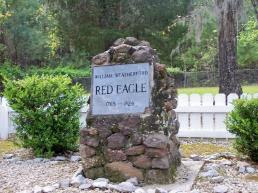In 1717, a party of French soldiers arrived at the head of the Alabama River near the modern cities of Wetumpka and Montgomery.
Their mission was to establish a permanent presence for the King of France in the deep wilderness of Alabama, then under the control of the Creek Nation. The French had cultivated strong ties with the Alabamas (also spelled Alibamos), who lived around the point where the Coosa and Tallapoosa Rivers joined to form the Alabama. A branch of the Upper Creeks, but possessing their own languages and customs, the Alabamas were actually a conglomeration of several smaller tribes.
The French needed a presence among them to half English expansion into the Creek country, which was then claimed not only by the Creeks and the French, but by the English and Spanish as well. A log fort called Fort Toulouse, named for the Count de Toulouse who was a son of King Louis XIV, was built on the Coosa River side of the point of land formed by the confluence of the Coosa and the Tallapoosa Rivers.
Despite its remote position deep in the wilderness that then covered virtually all of Alabama, the little settlement at Fort Toulouse survived for more than 45 years. The French built homes, cultivated gardens, intermarried with Indian women and engaged in trading and exploring. Although Fort Toulouse was surrounded by stockade walls and armed with small pieces of cannon, it owed its general survival to the goodwill of the Alabama who remained strongly loyal to the French despite the increasing influence of the English among the Creeks.
Over time, the fort was rebuilt at least once as the Coosa River slowly eroded away the bluff on which it stood. Archaeologists have found the remains of one of the corner bastions (angled projections that extended from the corners of the fort to allow infantry and cannon to sweep the walls in the event of an attack) of the original fort as well as buried traces of the second. Their work at the site has allowed modern interpreters to reconstruct Fort Toulouse so that visitors today can see the important early structure as it originally appeared.
Fort Toulouse was evacuated by the French in 1763 due to the treaty that ended the French and Indian War. Their homes and gardens were reclaimed by the forest and the fort itself soon rotted away. By the end of the century, the only remains still to be seen were a few old cannon abandoned at the site.
To learn more about Fort Toulouse and the other historic features of the site, please visit
www.exploresouthernhistory.com/forttoulouse.








